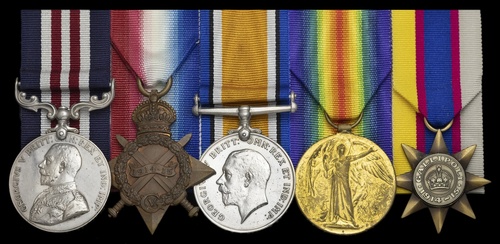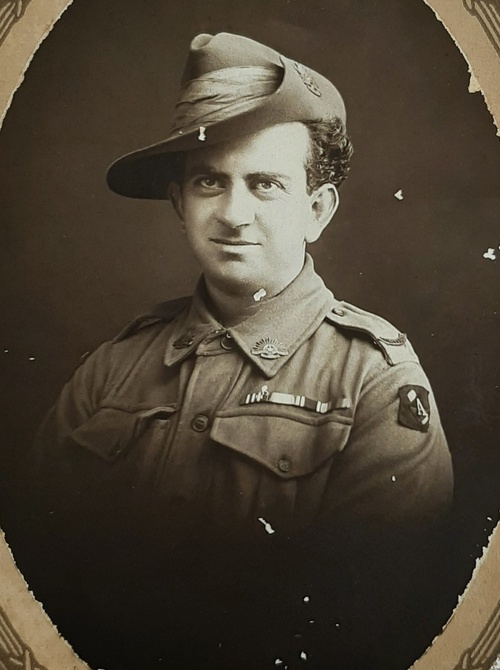Auction: 25001 - Orders, Decorations and Medals
Lot: 354
(x) The 'Trench Raid' 1916 M.M. group of five awarded to Private C. Murray, 19th Battalion, Australian Imperial Force, a Gallipoli veteran
Wounded in the neck during the second attempt on the Maze trench in November 1916, he survived and went on to become a famous artist in Australia
Military Medal, G.V.R. (1073 Pte. C. Murray. 19/Aust:Inf:Bn:); 1914-15 Star (1073 Pte C. Murray. 19/Bn. A.I.F.); British War and Victory Medals (1073 Pte C. Murray. 19 Bn. A.I.F.); Gallipoli Star 1914-15, marked to the reverse 'Collector's Item' and thus an unofficial award, light pitting and contact wear overall, very fine (5)
M.M. London Gazette 21 September 1916, the original recommendation states:
'For conspicuous bravery during period 25/28 July, 1916. During 48 hours intense bombardment of Pozieres, Pte Murray displayed great gallantry and ability in attending to wounded and carrying them in by night and day. For him to do this it was necessary from him to move outside the front line on the parados and also to bring his wounded men across open ground. He carried out his work with the utmost coolness under shell fire'
Originally recommended for the D.C.M.
Christopher William Murray was born at Geelong, Victoria on 8 September 1885, the son of John and Jane Murray, both native of Ireland. The young Murray's parents both died before he was ten leaving himself and his older brother as orphans. Made a ward of a state as a result he was placed at St. Augustine's Orphanage in Geelong where he learned the trade of boot making. He was also a member of the famous St. Augustine's band, discovering a love for music and art which would remain with him for the rest of his life. He studied art firstly at Geelong before joining the Melbourne Art Gallery and finally the Slade School of Art in London.
Enlisting on 28 May 1915 in New South Wales, Murray stated his trade as 'Artist' and was initially posted to 7/1st Battalion, A.I.F. However Murray's musical flare came to the fore and he applied to join the Band of 'C' Company, 19th Battalion. Joining them on 15 June 1915 he embarked upon the Ceramic and travelled to Egypt before entering the war at Gallipoli on 21 August 1915.
On the first day in the field the Battalion entered the Battle of Hill 60, they were later also engaged at Pope's Hill. 19th Battalion finally withdrew during the evacuation in January 1916 and returned to Egypt for a turn on the Suez Canal Defences. Once they had re-organised, they proceeded to France on 18 March 1916.
Not long after they arrived in France Murray was one of a small group who volunteered to undertake a trench raid near Pozieres where they would shortly go into action in the Battle of the Somme. Just 6 officers and 65 other ranks took part, the raid was considered extremely dangerous and in recognition of their gallantry in undertaking it each man who took part had a note of recognition made in their service papers.
It was during the Battle of Pozieres the following month that Murray was to earn his laurels. However, his luck ran out and he was seriously wounded by a gunshot in the neck near Guedecourt, North Flers on 5 November 1916. At the time the Battalion was engaged in a major attack against the Maze feature, and he was successfully recovered from the battlefield and taken to hospital.
The severity of the wound required some years of recuperation after which Murray was detached to No. 3 Australian Auxiliary Hospital on 17 February 1918. He remained serving there until the end of the war, not long after his detachment he was granted leave to study figure painting at the Slade School of Art in London. Murray returned to Australia on 22 August 1919 and was discharged on 7 December 1919, becoming a well-known artist in Australia as stated in his obituary, written on 2 January 1959:
"He was a painter known to the Melbourne Art Club, and praised by some critics, as 'artist's artist'. He was a musician who built himself a "cello" of Australian wood and he was a bootmaker. Born at Geelong 73 years ago, he became an orphan early in life. At the orphanage he learned the trade of boatmaking, and was a member of the famous St. Augustine's band which, under the direction of the well-known band leader, travelled all over Australia. He studied painting at Geelong, the Melbourne Art Gallery and the Slade School of Art in London.
He served in the 1st world war as a stretcher bearer, and won the Military Medal for gallantry in the trenches of France. After the war he made his living as a musician. He loved to work with his hands and occupied the last years of his life making the thousands of bricks of his home and studio at Emerald."
Murray died at Emerald, Queensland in January 1959; sold together with copied research.
Subject to 5% tax on Hammer Price in addition to 20% VAT on Buyer’s Premium.
Estimate
£400 to £500
Starting price
£320







